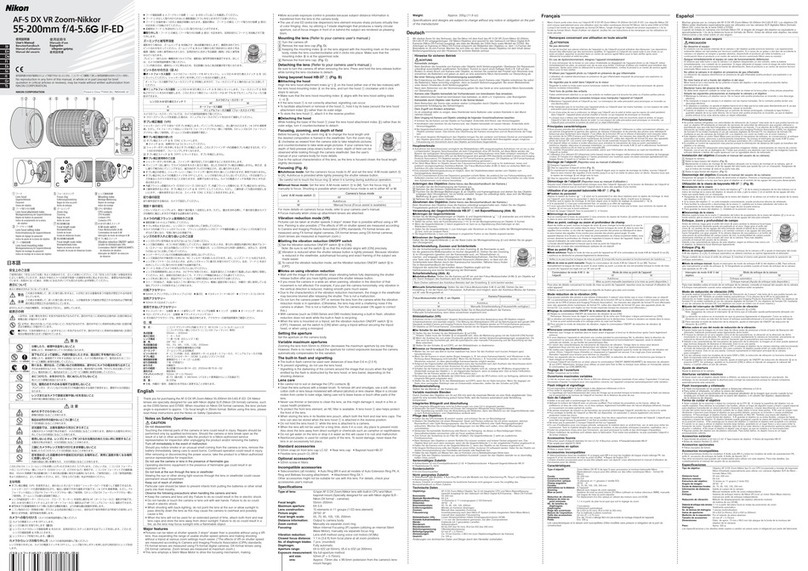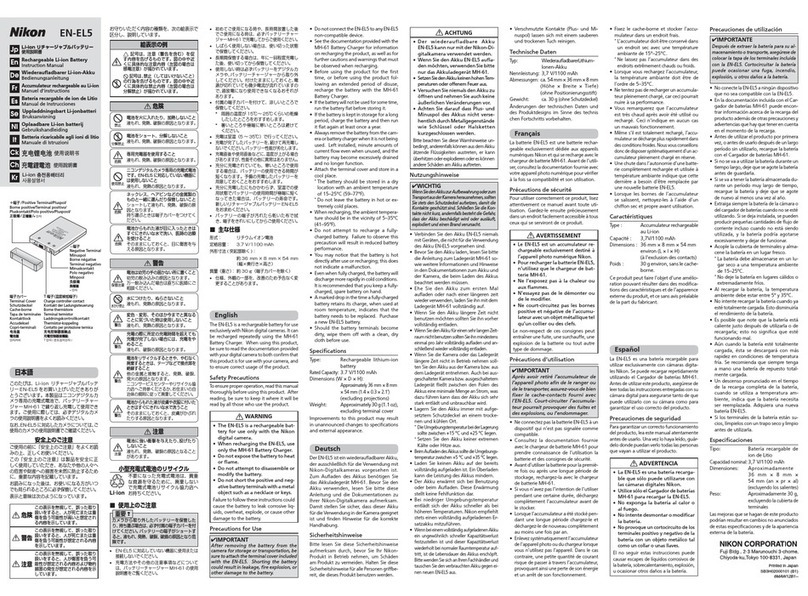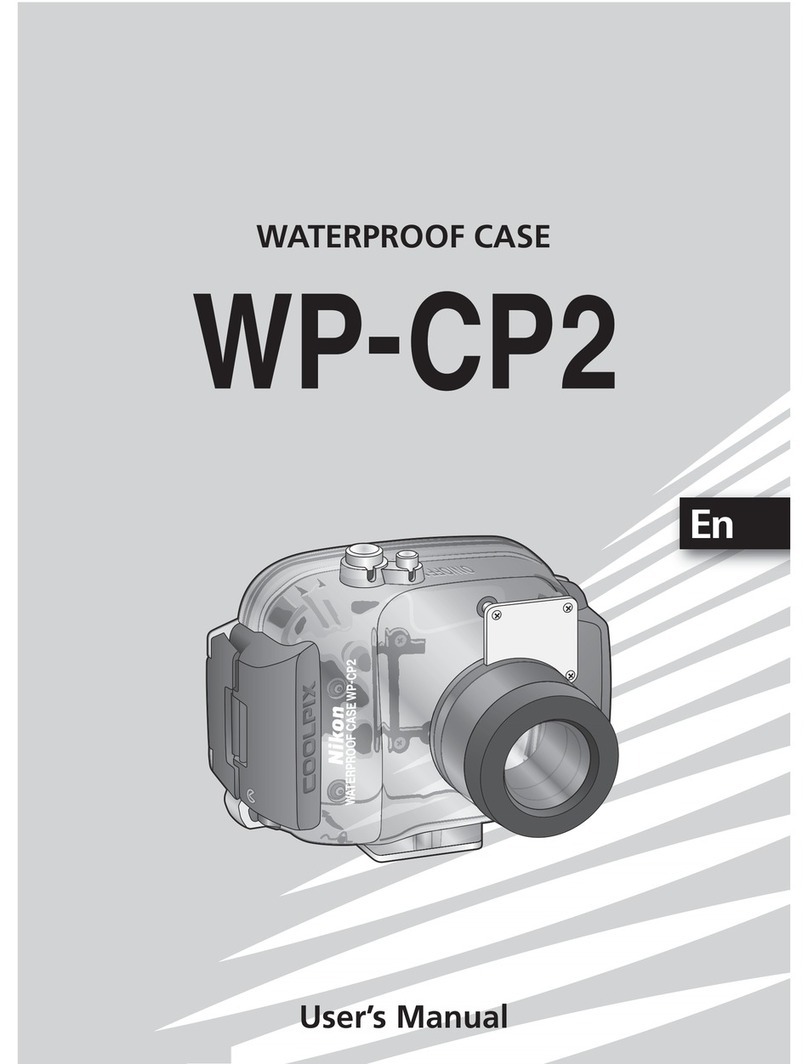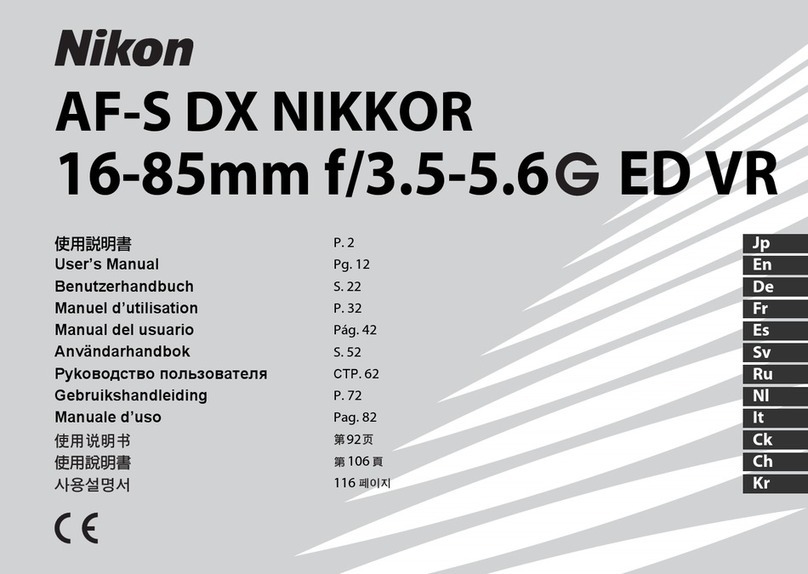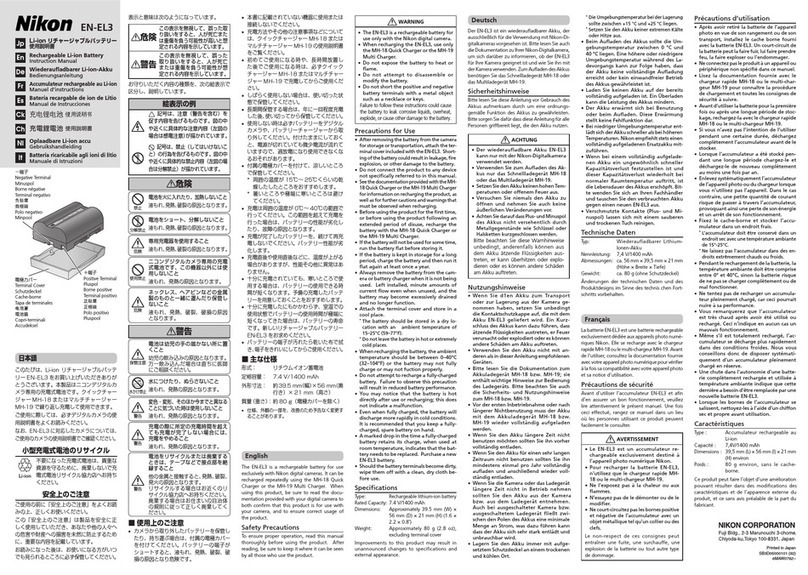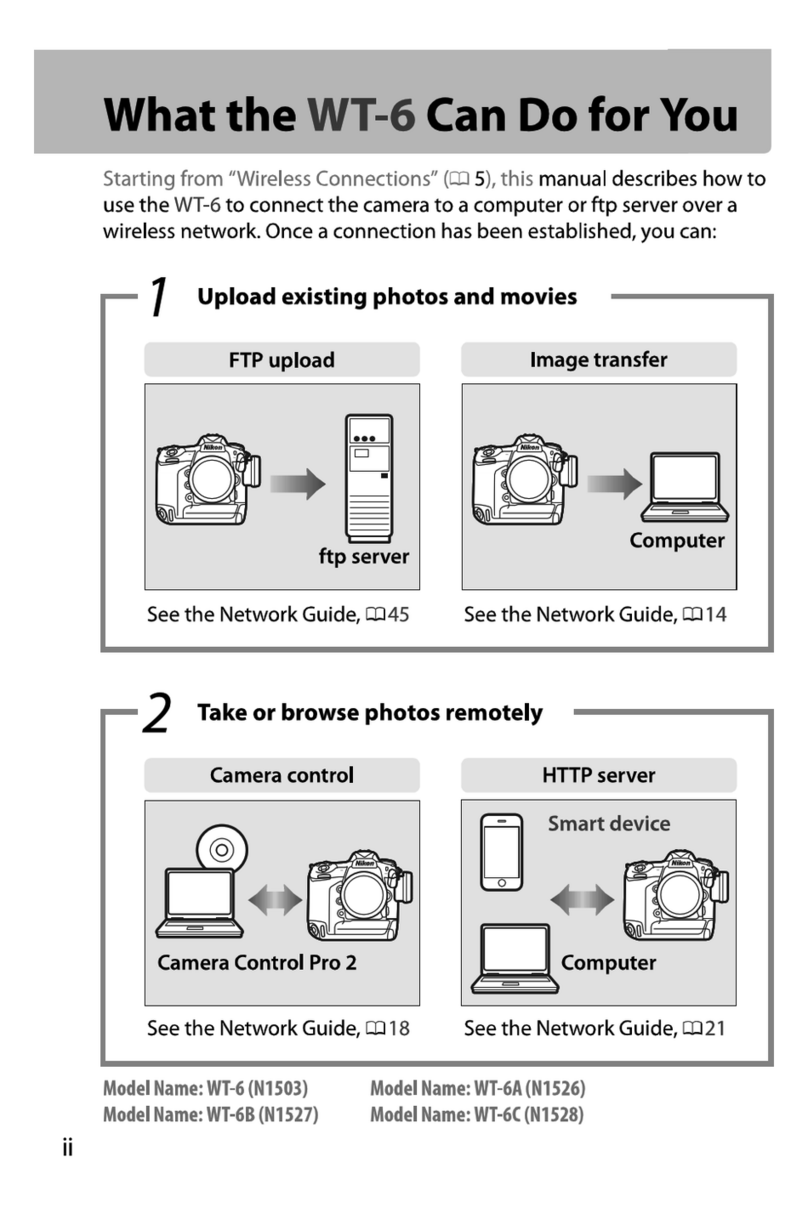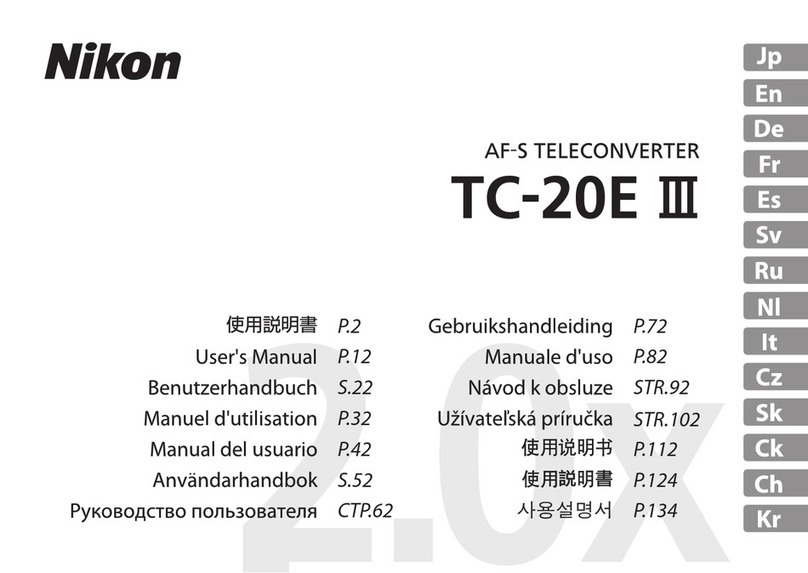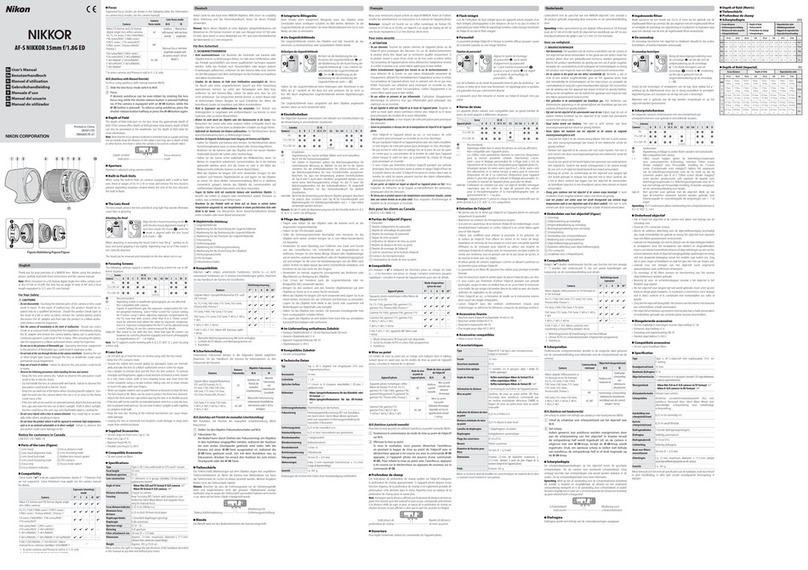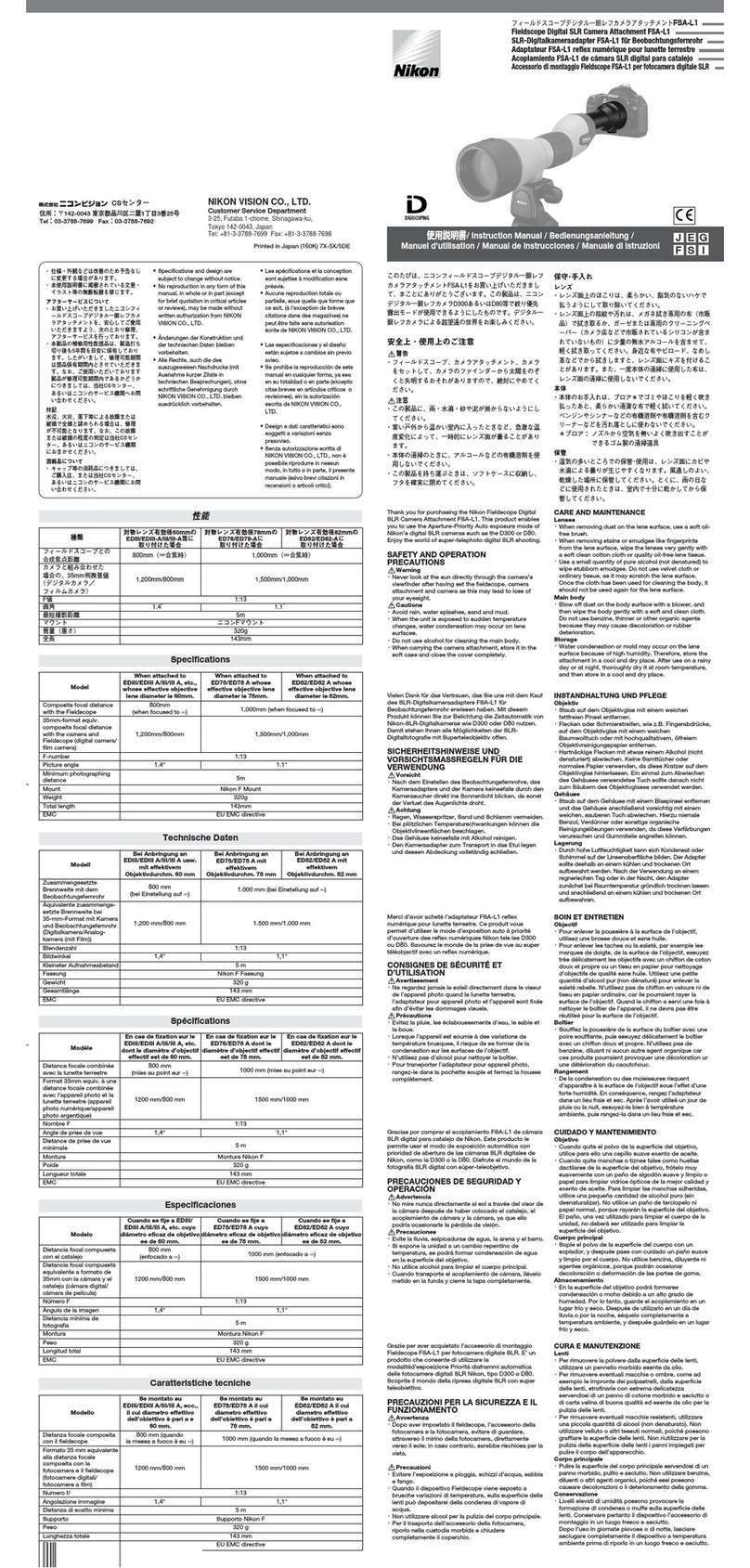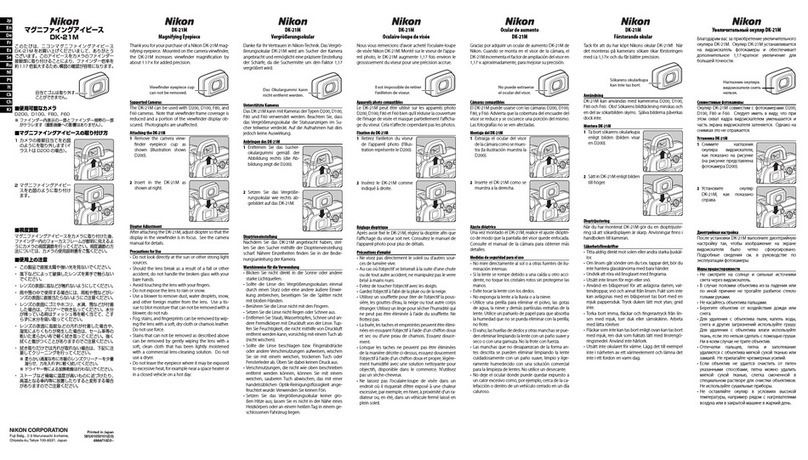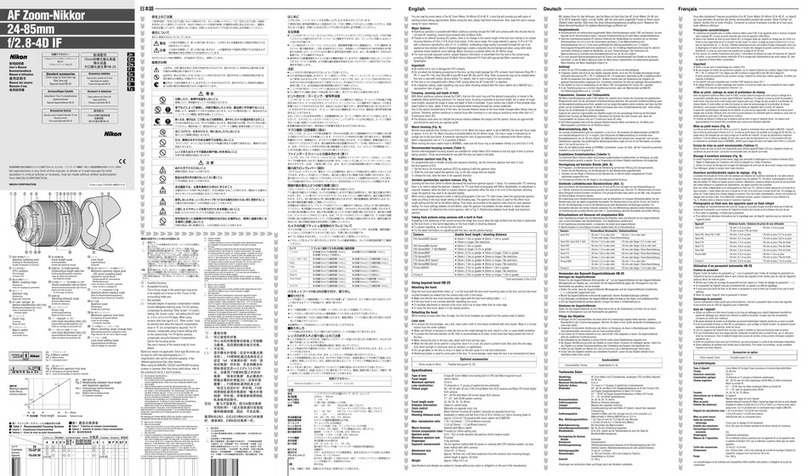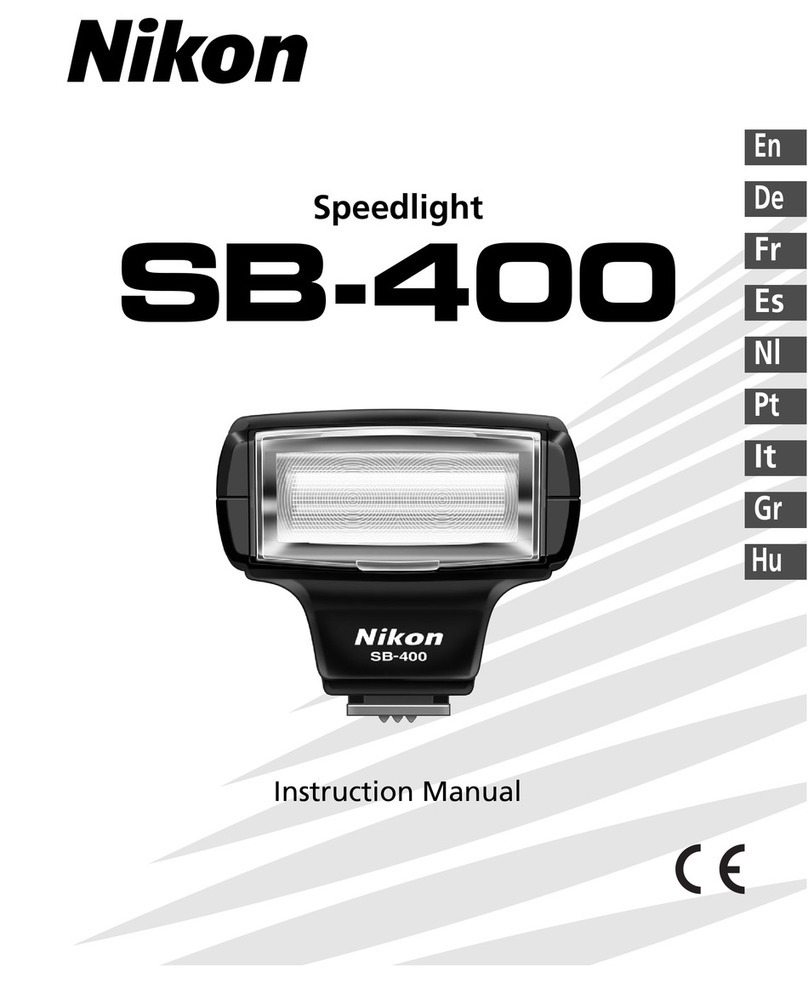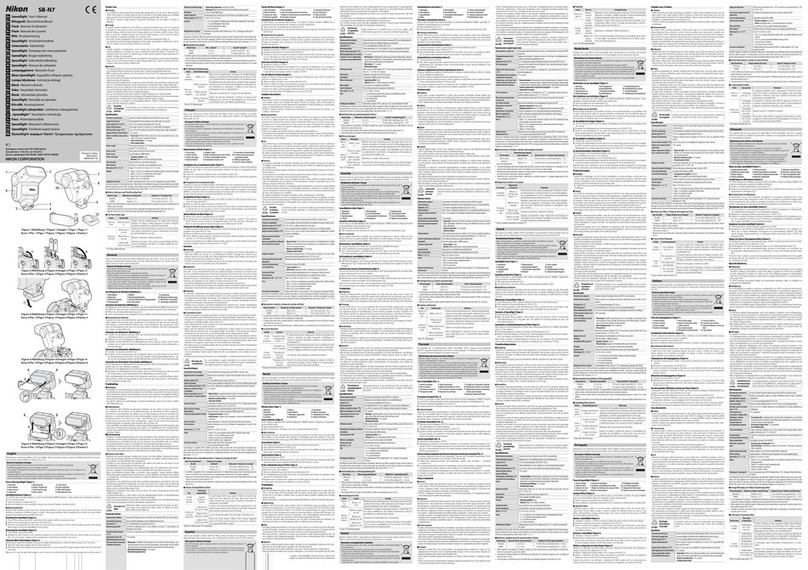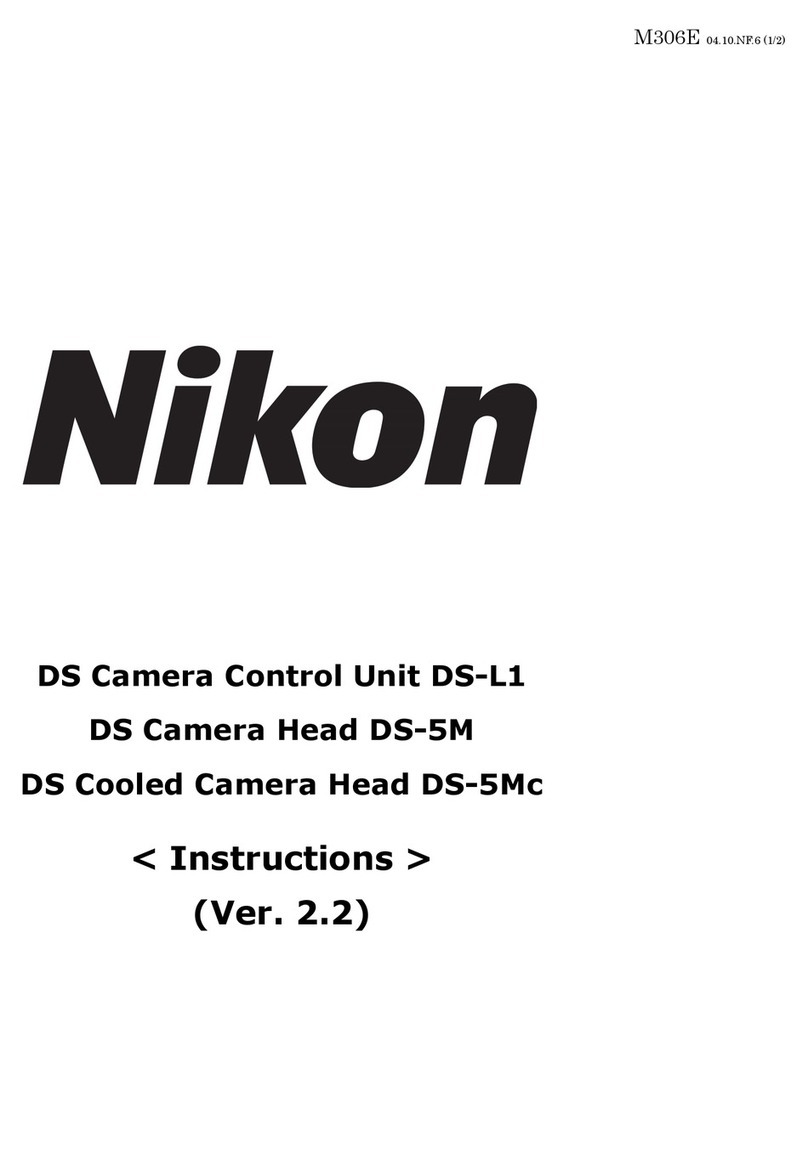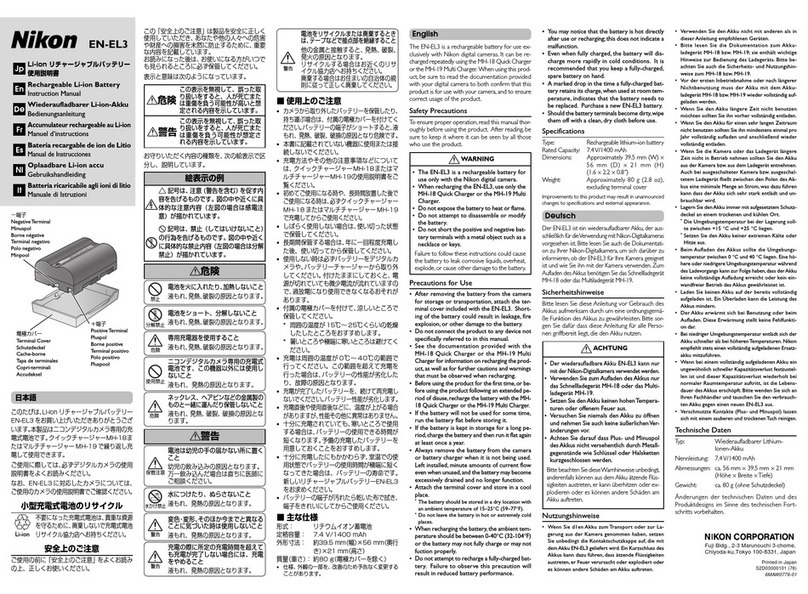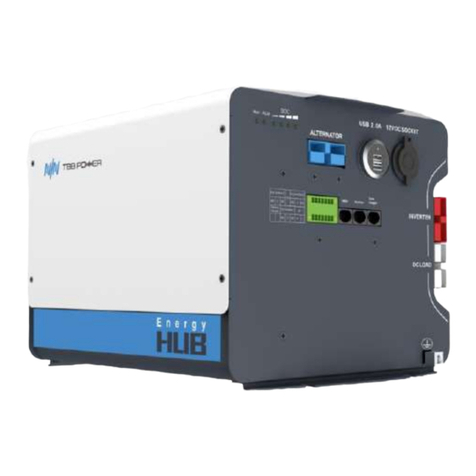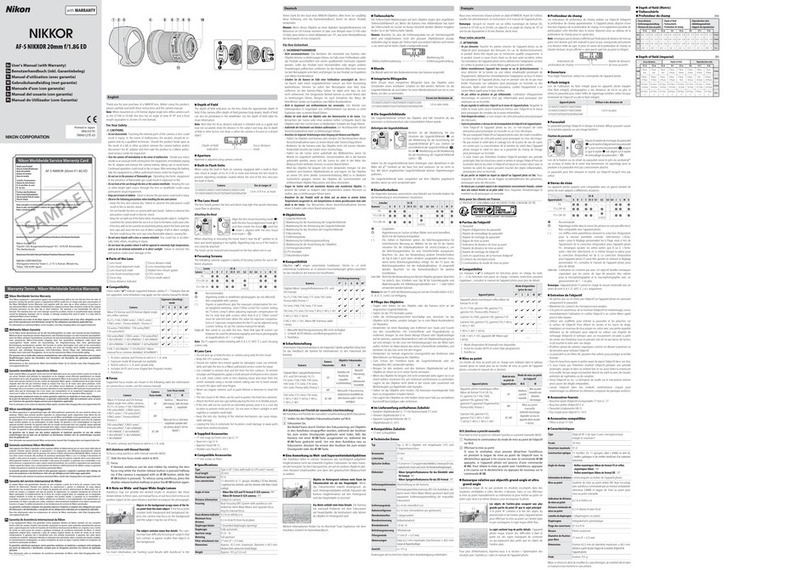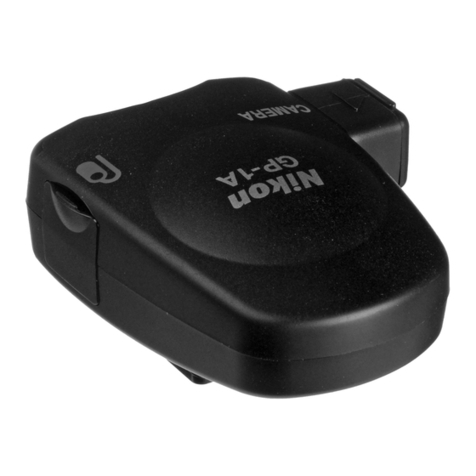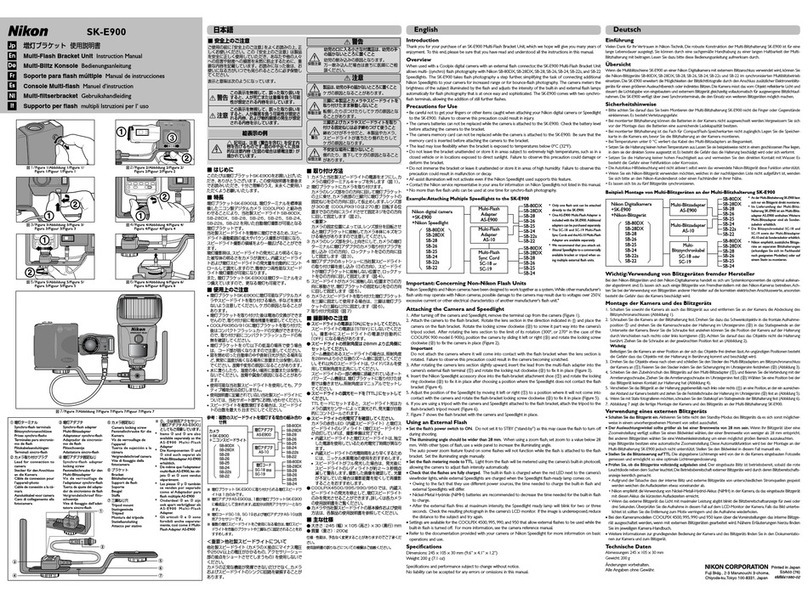
En
User’s Manual
Fr
Manuel d’utilisation
Sc
使用说明书
Tc
使用說明書
Id
Manual bagi Pengguna
Ar
Printed in Thailand
7MA0026C-01
AF-S DX NIKKOR 18–55mm f/3.5–5.6G VR II
DUMMY
Figure 2/Figure 2/图2
Figure 1/Figure 1/图1
English
Thank you for your purchase of a DX NIKKOR lens. Before using this product,
please carefully read both these instructions and the camera manual.
Note: DX lenses are for use with DX-format digital single-lens reflex cameras
such as the D7100 or D5200. The angle of view of a lens on a DX-format
camera is equivalent to that of a lens with a focal length about 1.5 × longer
mounted on a 35 mm format camera.
For Your Safety
A
CAUTIONS
• Do not disassemble. Touching the internal parts of the camera or lens could
result in injury. In the event of malfunction, the product should be re-
paired only by a qualified technician. Should the product break open as
the result of a fall or other accident, remove the camera battery and/or
disconnect the AC adapter and then take the product to a Nikon-autho-
rized service center for inspection.
• Turn the camera o immediately in the event of malfunction. Should you notice
smoke or an unusual smell coming from the equipment, immediately un-
plug the AC adapter and remove the camera battery, taking care to avoid
burns. Continued operation could result in fire or injury. After removing
the battery, take the equipment to a Nikon-authorized service center for
inspection.
• Do not use in the presence of ammable gas. Operating electronic equipment
in the presence of flammable gas could result in explosion or fire.
• Do not look at the sun through the lens or the camera viewnder. Viewing the sun
or other bright light source through the lens or viewfinder could cause
permanent visual impairment.
• Keep out of reach of children. Failure to observe this precaution could result
in injury.
• Observe the following precautions when handling the lens and camera:
-Keep the lens and camera dry. Failure to observe this precaution could
result in damage to the product, fire, or electric shock.
-Do not handle the lens or camera with wet hands. Failure to observe this
precaution could result in electric shock.
-Keep the sun well out of the frame when shooting backlit subjects. Sun-
light focused into the camera when the sun is in or close to the frame
could cause a fire.
-If the lens will not be used for an extended period, attach the front and rear
lens caps and store the lens out of direct sunlight. If left in direct sunlight,
the lens could focus the sun’s rays onto flammable objects, causing fire.
• Do not carry tripods with a lens or camera attached. You could trip or acciden-
tally strike others, resulting in injury.
• Do not leave the product where it will be exposed to extremely high temperatures,
such as in an enclosed automobile or in direct sunlight. Failure to observe this
precaution could cause damage or fire.
Notice for customers in Canada
Notice for customers in Canada
CAN ICES-3 B / NMB-3 B
■
Parts of the Lens (Figure 1)
Parts of the Lens (Figure 1)
qLens hood *
wLens hood lock mark
eLens hood alignment mark
rLens hood mounting mark
tFocus ring
yZoom ring
uRetractable lens barrel button
iFocal length scale
oFocal length mark
!0Lens mounting mark
!1CPU contacts
!2A-M mode switch
!3Vibration reduction ON/OFF switch
* Optional.
■
Attaching and Removing the Lens
Attaching and Removing the Lens
Attaching the Lens
z Turn the camera off and remove the camera body cap.
x Remove the rear lens cap.
cAttach the lens.
Keeping the lens mounting mark aligned with the mounting
mark on the camera body, position the lens in the camera’s
bayonet mount and then rotate the lens counter-clockwise
until it clicks into place with the lens mounting mark at the top.
Be careful not to press the retractable lens barrel button while
attaching or removing the lens.
Removing the Lens
z Turn the camera off.
x Remove the lens.
To remove the lens, press the lens release button while turning
the lens clockwise.
■
Before Use
The lens features a retractable barrel. Before using the camera, unlock and ex-
tend the zoom ring. Keeping the retractable lens barrel button pressed (q),
rotate the zoom ring as shown (w).
• To retract the lens, keep the retractable lens barrel button pressed and
rotate the zoom ring in the opposite direction until it locks.
• If the camera is turned on with the lens retracted, the camera will display
a warning,“F”, or“F”.
■
Focus
Focus mode is determined by the camera focus mode and the position of
the lens A-M mode switch. See the camera manual for information on cam-
era focus mode selection.
Camera focus mode
Lens focus mode
A
M
AF Autofocus Manual focus with electronic
rangefinder
MF —
Autofocus
z Set the camera to AF (autofocus).
x Slide the lens A-M mode switch to A.
cFocus.
Press the shutter-release button halfway to focus.
Manual Focus
zSlide the lens A-M mode switch to M.
xFocus.
Focus manually using the lens focus ring.
■
A Note on Wide- and Super Wide-Angle Lenses
A Note on Wide- and Super Wide-Angle Lenses
Autofocus may not provide the desired results in situations like those
shown below. In these cases, use manual focus, or use focus lock to focus on
another subject at the same distance and then recompose the photograph.
Objects in the background occupy more of the
focus point than the main subject: If the focus
point contains both foreground and
background objects, the camera may focus on
the background and the subject may be out of
focus.
The subject contains many ne details: The
camera may have difficulty focusing on
subjects that lack contrast or appear smaller
than objects in the background.
For more information, see “Getting Good Results with Autofocus” in the
camera manual.
■
Zoom and Depth of Field
Before focusing, rotate the zoom ring to adjust the focal length and frame
the photograph. If the camera offers depth-of-field preview (stop down),
depth of field can be previewed in the viewfinder.
Use the zoom ring to zoom in and out. Photographs can be taken only
when the focal length scale is between 18 and 55 mm (Figure 2).
■
Aperture
Aperture is adjusted using camera controls.
Zoom and Maximum Aperture
Zoom and Maximum Aperture
Changes to zoom can alter the maximum aperture by up to 1⁄ EV. The
camera however automatically takes this into account when setting expo-
sure, and no modifications to camera settings are required following adjust-
ments to zoom.
■
Built-in Flash Units
When using the built-in flash on cameras equipped with a built-in flash
unit, shoot at ranges of 0.6 m (2 ft) or more and remove the lens hood to
prevent vignetting (shadows created where the end of the lens obscures
the built-in flash).
■
Vibration Reduction (VR)
Vibration Reduction (VR)
Vibration reduction (VR) reduces blur caused by camera shake, allowing
shutter speeds up to 4.0 stops slower than would otherwise be the case *.
This increases the range of shutter speeds available and permits hand-held,
tripod-free photography in a wide range of situations.
* Measured at 55 mm with a DX-format camera according to Camera and
Imaging Products Association [CIPA] standards; effects vary with the pho-
tographer and shooting conditions.
Using the Vibration Reduction ON/OFF Switch
Using the Vibration Reduction ON/OFF Switch
• SelectON toenable vibration reduction. Vibration reduction is
activated when the shutter-release button is pressed halfway,
reducing the effects of camera shake for improved framing
and focus.
• Select OFF to turn vibration reduction o.
Using Vibration Reduction: Notes
Using Vibration Reduction: Notes
• When using vibration reduction, press the shutter-release button halfway
and wait for the image in the viewfinder to stabilize before pressing the
shutter-release button the rest of the way down.
• When vibration reduction is active, the image in the viewfinder may be
blurred after the shutter is released. This does not indicate a malfunction.
• When the camera is panned, vibration reduction applies only to motion
that is not part of the pan (if the camera is panned horizontally, for ex-
ample, vibration reduction will be applied only to vertical shake), making
it much easier to pan the camera smoothly in a wide arc.
• Do not turn the camera off or remove the lens while vibration reduction
is in effect.
• If the camera is equipped with a built-in flash, vibration reduction will be
disabled while the flash charges.
• Select OFF when the camera is mounted on a tripod unless the tripod
head is unsecured or the camera is mounted on a monopod, in which
case ON is recommended.
■
The Optional Lens Hood
The lens hoods protect the lens and block stray light that would otherwise
cause flare or ghosting.
Attaching the Hood
Align the lens hood mounting mark
(●) with the lens hood alignment
mark ( ) and then rotate the hood
(w) until the ●mark is aligned with
the lens hood lock mark (—).
When attaching or removing the hood, hold it near the symbol on its
base and avoid gripping it too tightly. Vignetting may occur if the hood is
not correctly attached.
The hood can be reversed and mounted on the lens when not in use.
■
Lens Care
• Do not pick up or hold the lens or camera using only the lens hood.
• Keep the CPU contacts clean.
• Use a blower to remove dust and lint from the lens surfaces. To remove
smudges and fingerprints, apply a small amount of ethanol or lens cleaner
to a soft, clean cotton cloth or lens-cleaning tissue and clean from the
center outwards using a circular motion, taking care not to leave smears
or touch the glass with your fingers.
• Never use organic solvents such as paint thinner or benzene to clean the lens.
• The lens hood or NC filters can be used to protect the front lens element.
• Attach the front and rear caps before placing the lens in its flexible pouch.
• If the lens will not be used for an extended period, store it in a cool, dry loca-
tion to prevent mold and rust. Do not store in direct sunlight or with naphtha
or camphor moth balls.
• Keep the lens dry. Rusting of the internal mechanism can cause irrepa-
rable damage.
• Leaving the lens in extremely hot locations could damage or warp parts
made from reinforced plastic.
■
Supplied Accessories
• 52 mm snap-on Front Lens Cap LC-52
• Rear Lens Cap
■
Compatible Accessories
• 52 mm screw-on filters
• Bayonet Hood HB-69
• Flexible Lens Pouch CL-0815
• Rear Lens Cap LF-4
■
Specifications
Type Type G AF-S DX lens with built-in CPU and F mount
Focal length 18– 55 mm
Maximum aperture f/3.5– 5.6
Lens construction 11 elements in 8 groups (including 1 aspherical lens ele-
ment)
Angle of view 76°– 28°50
Focal length scale Graduated in millimeters (18, 24, 35, 45, 55)
Distance information Output to camera
Zoom Manual zoom using independent zoom ring
Focusing Autofocus controlled by Silent Wave Motor and
separate focus ring for manual focus
Vibration reduction Lens shift using voice coil motors (VCMs)
Minimum focus
distance
• AF: 0.28 m (0.92 ft) from focal plane at all zoom
positions
• MF: 0.25 m (0.82 ft) from focal plane at all zoom
positions
Diaphragm blades 7 (rounded diaphragm opening)
Diaphragm Fully automatic
Aperture range • 18mmfocal length: f/3.5–22
• 55mmfocal length: f/5.6–36
The minimum aperture displayed may vary de-
pending on the size of the exposure increment
selected with the camera.
Metering Full aperture
Filter-attachment size 52 mm (P = 0.75 mm)
Dimensions Approx. 66 mm maximum diameter × 59.5 mm
(distance from camera lens mount ange when lens is retracted)
Weight Approx. 195 g (6.9 oz)
Nikon reserves the right to change the specifications of the hardware described
in this manual at any time and without prior notice.
Français
Nous vous remercions d’avoir acheté un objectif DX NIKKOR. Avant d’utiliser ce pro-
duit, veuillez lire attentivement à la fois ces instructions et le manuel de l’appareil
photo.
Remarque: les objectifs DX sont destinés aux reex numériques de format DX,
comme le D7100 ou le D5200. L’angle de champ d’un objectif xé sur un ap-
pareil photo de format DX est égal à environ 1,5 × celui d’un objectif xé sur
un appareil photo 24x36 mm.
Pour votre sécurité
A
ATTENTION
• Ne pas démonter. Toucher les parties internes de l’appareil photo ou de l’objectif
peut provoquer des blessures. En cas de dysfonctionnement, le produit devra
être réparé par un technicien qualifié uniquement. Si le produit s’ouvre à cause
d’une chute ou de tout autre accident, retirez l’accumulateur de l’appareil
photo et/ou débranchez l’adaptateur secteur et confiez le produit à un centre
Nikon agréé pour le faire vérifier.
• Mettre immédiatement l’appareil hors tension en cas de dysfonctionnement. Si vous
détectez de la fumée ou une odeur inhabituelle provenant de l’équipement,
débranchez immédiatement l’adaptateur secteur et retirez l’accumulateur de
l’appareil photo, tout en prenant soin de ne pas vous brûler. Poursuivre son
utilisation peut provoquer un incendie ou des blessures. Après avoir retiré
l’accumulateur, confiez l’équipement à un centre Nikon agréé pour le faire vérifier.
• Nepas utiliser en présence degazinammable. L’utilisation d’équipement électronique
en présence d’un gaz inflammable peut provoquer une explosion ou un incendie.
• Ne pas regarder le soleil avec l’objectif ou le viseur de l’appareil photo. Regarder le
soleil ou toute autre source lumineuse intense avec l’objectif ou le viseur peut
provoquer des troubles de la vision irréversibles.
• Tenir éloigné des enfants. Le non-respect de cette précaution peut provoquer des
blessures.
• Suivre les précautions ci-dessous lors de la manipulation de l’objectif et de l’appareil photo :
-Maintenez l’objectif et l’appareil photo propres. Le non-respect de cette
consigne de sécurité peut endommager le produit, déclencher un feu ou
un choc électrique.
-Ne pas manipuler l’objectif ou l’appareil photo avec des mains mouillées. Le
non-respect de cette précaution peut provoquer un choc électrique.
-Ne pas inclure le soleil dans le cadrage lors de la prise de vue de sujets
en contre-jour. La concentration de la lumière du soleil dans l’appareil
photo lorsque le soleil est dans ou à proximité du champ de l’image peut
déclencher un feu.
-Si vous n’avez pas l’intention d’utiliser l’objectif pendant une période
prolongée, fixez les bouchons avant et arrière et rangez l’objectif hors de
la lumière directe du soleil. Si l’objectif est laissé en contact direct avec la
lumière du soleil, les rayons peuvent toucher des objets inflammables, et
déclencher un feu.
• Ne pas transporter un trépied avec un objectif ou un appareil photo xé dessus. Vous
risqueriez de trébucher ou de frapper accidentellement des personnes,
provoquant ainsi des blessures.
• Ne laissez pas ce produit exposé à des températures excessivement chaudes, comme dans
une voiture fermée ou en plein soleil. Vous risqueriez d’endommager le matériel ou
de provoquer un incendie.
Avis pour les clients au Canada
Avis pour les clients au Canada
CAN ICES-3 B / NMB-3 B
■
Parties de l’objectif (Figure 1)
Parties de l’objectif (Figure 1)
qParasoleil *
wRepère de verrouillage du parasoleil
eRepère d’alignement du parasoleil
rRepère de montage du parasoleil
tBague de mise au point
yBague de zoom
uCommande de déverrouillage de l’objectif rétractable
iÉchelle des focales
oRepère de l’échelle des focales
!0 Repère de montage de l’objectif
!1 Contacts du microprocesseur
!2 Commutateur de mode A-M
!3 Commutateur ON/OFF de réduction de vibration
* Optionnel.
■
Fixer et retirer l’objectif
Fixer et retirer l’objectif
Fixer l’objectif
z Mettez l’appareil photo hors tension et retirez son bouchon de boîtier.
x Retirez le bouchon arrière de l’objectif.
cFixez l’objectif.
En maintenant le repère de montage de l’objectif aligné avec le repère
de montage sur le boîtier de l’appareil photo, positionnez l’objectif
dans la monture à baïonnette de l’appareil, puis faites tourner
l’objectif dans le sens opposé des aiguilles d’une montre jusqu’à ce
qu’il s’emboîte, le repère de montage de l’objectif vers le haut.
Faites attention de ne pas appuyer sur la commande de déverrouillage
de l’objectif rétractable lorsque vous fixez ou retirez l’objectif.
Retirer l’objectif
z Mettez l’appareil photo hors tension.
x Retirez l’objectif.
Pour retirer l’objectif, appuyez sur la commande de déverrouillage
de l’objectif tout en tournant l’objectif dans le sens des aiguilles
d’une montre.
■
Avant toute utilisation
Cet objectif dispose d’un barillet rétractable. Avant d’utiliser l’appareil photo, déver-
rouillez et sortez la bague de zoom. En maintenant appuyée la commande de déver-
rouillage de l’objectif rétractable (q), tournez la bague de zoom comme illustré (w).
• Pour rétracter l’objectif, maintenez appuyée la commande de déverrouillage
de l’objectif rétractable et tournez la bague de zoom dans le sens inverse
jusqu’à ce qu’elle se verrouille.
• Si vous mettez l’appareil photo sous tension alors que l’objectif est rétracté, un
message d’avertissement s’affiche : « F» ou « F».
■
Mise au point
Le mode de mise au point est déterminé par le mode de mise au point de l’appareil
photo et la position du commutateur de mode A-M de l’objectif. Reportez-vous au
manuel de l’appareil photo pour plus d’informations sur la sélection du mode de
mise au point de l’appareil photo.
Mode de mise au point de
l’appareil photo
Mode de mise au point de l’objectif
Mode de mise au point de l’objectif
A
M
AF Autofocus Mise au point manuelle avec
télémètre électronique
MF —
Autofocus
zRéglez l’appareil photo sur AF (autofocus).
xPositionnez le commutateur de mode A-M de l’objectif sur A.
cEffectuez la mise au point.
Appuyez sur le déclencheur à mi-course pour faire la mise au point.
Mise au point manuelle
zPositionnez le commutateur de mode A-M de l’objectif sur M.
xEffectuez la mise au point.
Effectuez la mise au point manuellement en utilisant la bague de
mise au point de l’objectif.
■
Remarque relative aux objectifs grand-angle et ultra grand-angle
Remarque relative aux objectifs grand-angle et ultra grand-angle
L’autofocus risque de ne pas produire les résultats escomptés dans des situations
semblables à celles décrites ci-dessous. Dans ce cas, effectuez la mise au point ma-
nuellement ou mémorisez-la pour mettre au point un autre sujet situé à la même
distance, puis recomposer la photo.
Les objets de l’arrière-plan occupent une plus grande
partie du point AF que le sujet principal : si le point
AF contient à la fois des objets du premier plan et
de l’arrière-plan, l’appareil photo peut effectuer la
mise au point sur l’arrière-plan et par conséquent,
le sujet risque d’être flou.
Le sujet contient trop de petits détails : l’appareil
photo risque d’avoir des difficultés à faire le point
sur des sujets manquant de contraste ou qui
paraissent plus petits que les objets de l’arrière-
plan.
Pour plus d’informations, reportez-vous à la section « Optimisation des résul-
tats avec l’autofocus » dans le manuel de l’appareil photo.
■
Zoom et profondeur de champ
Zoom et profondeur de champ
Avant de faire la mise au point, tournez la bague de zoom pour régler la focale et ca-
drer la photographie. Si l’appareil photo offre un aperçu de la profondeur de champ
(fermeture du diaphragme), il est possible d’avoir un aperçu de la profondeur de
champ dans le viseur.
Utilisez la bague de zoom pour eectuer des zooms avant et arrière. Il n’est
possible de prendre des photos que lorsque l’échelle des focales est entre 18
et 55 mm (Figure 2).
■
Ouverture
Pour régler l’ouverture, utilisez les commandes de l’appareil photo.
Zoom et ouverture maximale
Zoom et ouverture maximale
Modifier le zoom peut altérer l’ouverture maximale jusqu’à 1⁄L. L’appareil photo
prend cela automatiquement en compte lors du réglage de l’exposition et aucune
modification des réglages de l’appareil photo n’est nécessaire après les ajustements
du zoom.
■
Flash intégré
Lors de l’utilisation du flash intégré (pour les appareils photo équipés d’un flash in-
tégré), photographiez à des distances de 0,6 m ou plus et retirez le parasoleil pour
éviter l’effet de vignettage (ombres créées lorsque l’extrémité de l’objectif occulte le
flash intégré).
■
Réduction de vibration (VR)
Réduction de vibration (VR)
La fonction de réduction de vibration (VR) atténue les phénomènes de flou provo-
qués par le bougé de l’appareil photo, ce qui permet de recourir à des vitesses d’obtu-
ration jusqu’à 4,0 fois plus lentes que celles normalement utilisées*. Cela augmente la
plage des vitesses d’obturation disponibles et permet de prendre des photos à main
levée, sans trépied, dans de nombreuses situations.
* Mesures effectuées à 55 mm avec un appareil photo de format DX selon les
normes de la CIPA (Camera and Imaging Products Association) ; les effets
varient selon le photographe et les conditions de prise de vue.
Utilisation du commutateur ON/OFF pour la réduction de vibration
Utilisation du commutateur ON/OFF pour la réduction de vibration
• Sélectionnez ON (ACTIVÉ) pour activer la réduction de vibration. La
réduction de vibration est activée lorsque vous appuyez à mi-
course sur le déclencheur, réduisant ainsi les effets du bougé
d’appareil pour vous permettre d’améliorer le cadrage et la
mise au point.
• Sélectionnez OFF (DÉSACTIVÉ) pour désactiver la réduction de
vibration.
Utiliser la réduction de vibration : remarques
Utiliser la réduction de vibration : remarques
• Lorsque vous utilisez la réduction de vibration, appuyez sur le déclencheur à
mi-course et attendez que l’image se stabilise dans le viseur avant d’appuyer
sur le déclencheur jusqu’en fin de course.
• Lorsque la réduction de vibration est activée, l’image dans le viseur peut être
floueunefoisledéclencheurrelâché.Cela n’indique pas un dysfonctionnement.
• Lorsque l’appareil photo est en mode panoramique, la réduction de vibration
s’applique uniquement au mouvement ne faisant pas partie du panoramique
(si l’appareil photo est en mode panoramique horizontal par exemple, la
réduction de vibration s’applique uniquement au mouvement vertical), Vous
pouvez ainsi faire plus facilement un panoramique régulier en un arc large.
• Ne mettez pas l’appareil photo hors tension et ne retirez pas l’objectif pendant
que la réduction de vibration est activée.
• Si l’appareil photo est équipé d’un flash intégré, la réduction de vibration est
désactivée pendant que le flash se charge.
• Sélectionnez OFF lorsque l’appareil photo est monté sur un trépied sauf si la
tête du trépied n’est pas fixée ou si l’appareil est monté sur un monopode ;
dans ce cas, ON est recommandé.
■
Parasoleil optionnel
Le parasoleil protège l’objectif et bloque la lumière diffuse pouvant causer de la lu-
mière parasite ou une image fantôme.
Fixation du parasoleil
Alignez le repère de montage du parasoleil
(●) sur le repère d’alignement du
parasoleil ( ), puis tournez le parasoleil
(w) jusqu’à ce que le repère ●soit aligné
sur le repère de verrouillage du parasoleil
(—).
Lors de la xation ou du retrait du parasoleil, tenez-le près du symbole sur
sa base, et évitez de le serrer trop fermement. Un vignettage peut se produire
si le parasoleil n’est pas correctement attaché.
Le parasoleil peut être retourné et monté sur l’objectif lorsqu’il n’est pas utilisé.
■
Entretien de l’objectif
• Ne prenez pas ou ne tenez pas l’objectif ou l’appareil photo en saisissant
uniquement le parasoleil.
• Maintenez les contacts du microprocesseur propres.
• Utilisez une soufflette pour enlever la poussière et les peluches sur la surface de
l’objectif. Pour effacer les taches et les traces de doigt, imprégnez un morceau
de tissu propre en coton avec une petite quantité d’éthanol ou de nettoyant
pour objectif ou utilisez une lingette de nettoyage d’objectif, et nettoyez avec
un mouvement circulaire à partir du centre vers l’extérieur, tout en prenant
soin de ne pas laisser de taches, ni de toucher le verre avec vos doigts.
• N’utilisez jamais de solvants organiques comme un diluant à peinture ou du
benzène pour nettoyer l’objectif.
• Le parasoleil ou les filtres NC peuvent être utilisés pour protéger la lentille
frontale.
• Fixez les bouchons avant et arrière avant de placer l’objectif dans son étui.
• Si vous n’avez pas l’intention d’utiliser l’objectif pendant une période
prolongée, rangez-le dans un endroit frais et sec pour éviter la moisissure et
la rouille. Ne le rangez pas à la lumière directe du soleil ou avec des boules
antimites de naphtaline ou de camphre.
• Tenez l’objectif au sec. La formation de rouille sur le mécanisme interne peut
causer des dégâts irréparables.
• Laisser l’objectif dans des endroits extrêmement chauds peut endommager
ou déformer les éléments composés de plastique renforcé.
■
Accessoires fournis
• Bouchon avant d’objectif encliquetable 52 mm LC-52
• Bouchon arrière d’objectif
■
Accessoires compatibles
• Filtres à visser 52 mm
• Parasoleil à baïonnette HB-69
• Étui souple pour objectif CL-0815
• Bouchon arrière d’objectif LF-4
■
Caractéristiques
Type Objectif AF-S DX de type G avec microprocesseur
intégré et monture F
Focale 18– 55 mm
Ouverture maximale f/3.5– 5.6
Construction optique 11 lentilles en 8 groupes (dont 1 lentille asphérique)
Angle de champ 76°– 28°50
Échelle des focales Graduée en millimètres (18, 24, 35, 45, 55)
Information de distance Communiquée au boîtier de l’appareil photo
Zoom Zoom manuel utilisant une bague de zoom
indépendante
Mise au point Autofocus commandé par un moteur ondulatoire
silencieux (SWM) et bague de mise au point pour
mise au point manuelle
Réduction de vibration Décentrement avec voice coil motors (VCMs)
Distance minimale de mise
Distance minimale de mise
au point
• AF: 0,28 m depuis le plan focal à toutes les focales
• MF: 0,25 m depuis le plan focal à toutes les focales
Lamelles de diaphragme 7 (diaphragme circulaire)
Diaphragme Intégralement automatique
Plage des ouvertures • Focale 18 mm : f/3.5 à f/22
• Focale 55 mm : f/5.6 à f/36
L’ouverture minimale affichée peut varier en
fonction de l’incrément d’exposition sélectionné
avec l’appareil photo.
Mesure Pleine ouverture
Diamètre de fixation pour
Diamètre de fixation pour
filtre 52 mm (P = 0,75 mm)
Dimensions Environ 66 mm de diamètre maximum × 59,5 mm
(distance à partir du plan d’appui de la monture d’objectif de
l’appareil photo lorsque l’objectif est rétracté)
Poids Environ 195 g
Nikon se réserve le droit de modifier les caractéristiques du matériel décrit dans ce
manuel à tout moment et sans préavis.
中文版(简体)
使用产品前请仔细阅读本使用说明书,并请妥善保管。
感谢您购买DX 尼克尔镜头。在使用本产品前,请仔细阅读这些指
南和照相机的说明书。
注意:
DX 镜头适用于DX 格式数码单镜反光照相机(如D7100 或
D5200)。DX 格式照相机上镜头的视角,相当于安装在35 mm 格
式照相机上焦距约为该镜头1.5倍的镜头的视角。
安全须知
请在使用前仔细阅读“安全须知”,并以正确的方法使用。本“安全
须知”中记载了重要的内容,可使您能够安全、正确地使用产品,并
预防对您或他人造成人身伤害或财产损失。请在阅读之后妥善保管,
以便本产品的所有使用者可以随时查阅。
有关指示
本节中标注的指示和含义如下。
A警告 表示若不遵守该项指示或操作不当,则有可能造成
人员死亡或负重伤的内容。
A注意 表示若不遵守该项指示或操作不当,则有可能造成人
员伤害、以及有可能造成物品损害的内容。
本节使用以下图示和符号对必须遵守的内容作分类和说明。
图示和符号的实例
IL符号表示唤起注意(包括警告)的内容。
在图示中或图示附近标有具体的注意内容(左图之例为当心
触电)。
EF符号表示禁止(不允许进行的)的行为。
在图示中或图示附近标有具体的禁止内容(左图之例为禁止
拆解)。
KD符号表示强制执行(必需进行)的行为。
在图示中或图示附近标有具体的强制执行内容(左图之例为
取出电池)。
A警告
E禁止
拆解
切勿自行拆解、修理或改装。
否则将会造成触电、发生故障并导致受伤。
G
C
禁止
触碰
立即委
托修理
当产品由于跌落而破损使得内部外露时,切勿用手
触碰外露部分。
否则将会造成触电、或由于破损部分而导致受伤。取
出照相机电池,并委托经销商或尼康授权的维修服
务中心进行修理。
K
C
取出电
池
立即委
托修理
当发现产品变热、冒烟或发出焦味等异常时,请立
刻取出照相机电池。
若在此情况下继续使用,将会导致火灾或灼伤。
取出电池时,请小心勿被烫伤。
取出电池,并委托经销商或尼康授权的维修服务中
心进行修理。
J禁止
接触
水
切勿浸入水中或接触到水,或被雨水淋湿。
否则将会引起火灾或触电等事故,或导致产品受损。
F禁止使
用
切勿在有可能起火、爆炸的场所使用。
在有丙烷气、汽油、可燃性喷雾剂等易燃性气体、粉
尘的场所使用产品,将会导致爆炸或火灾。
F禁止观
看
切勿用镜头或照相机直接观看太阳或强光。
否则将会导致失明或视觉损伤。
A注意
I当心触
电
切勿用湿手触碰。
否则将有可能导致触电。
F禁止
放置
切勿在婴幼儿伸手可及之处保管产品。
否则将有可能导致受伤。
A小心
使用
进行逆光拍摄时,务必使太阳充分偏离视角。
阳光会在照相机内部聚焦,并有可能导致火灾。
太阳偏离视角的距离微小时,也有可能会导致火灾。
A妥善
保存
不使用时请盖上镜头盖,或保存在没有阳光照射处。
阳光会聚焦,并有可能导致火灾。
A小心移
动
进行移动时,切勿将照相机或镜头安装在三脚架上。
摔倒、碰撞时将有可能导致受伤。
F禁止
放置
切勿将本产品放置于封闭的车辆中、直射阳光下或
其他异常高温之处,否则可能导致产品受损或引起火
灾。
■镜头部件(图 1
)
q镜头遮光罩※
w镜头遮光罩锁定标记
e镜头遮光罩对齐标记
r镜头遮光罩安装标记
t对焦环
y变焦环
u可伸缩镜头镜筒按钮
i焦距刻度
o焦距标记
!0 镜头安装标记
!1 CPU接点
!2 A-M模式切换器
!3 减震 ON/OFF开关
※
另购。
■安装和取下镜头
安装镜头
z关闭照相机并取下照相机机身盖。
x取下镜头后盖。
c安装镜头。
将镜头安装标记和照相机机身上的安装标记对齐,再将镜头插
入照相机的卡口中,然后逆时针旋转镜头直至其卡入正确位置
发出咔嗒声,此时镜头安装标记在顶部。
安装或取下镜头时,请小心不要按下可伸缩镜头镜筒按钮。
取下镜头
z关闭照相机。
x取下镜头。
若要取下镜头,请按住镜头释放按钮并同时顺时针旋转镜头。
■使用之前
本镜头配备有一个可伸缩镜筒。使用照相机之前,请先解除锁定并
伸出变焦环。如图所示按住可伸缩镜头镜筒按钮(
q
),同时旋转变
焦环(
w
)。
• 若要缩回镜头,请按住可伸缩镜头镜筒按钮并同时按相反方向旋
转变焦环直至其锁定。
• 若在镜头处于缩回状态时开启照相机,照相机将显示警告图标
“F”或“
F”。
■对焦
对焦模式由照相机对焦模式和镜头A-M 模式切换器的位置决定。
有关选择照相机对焦模式的信息,请参阅照相机的说明书。
照相机对焦模式
镜头对焦模式
AM
AF 自动对焦
带有电子测距仪的手动对焦
MF —
自动对焦
z将照相机设定为AF
(自动 对 焦)。
x将镜头A-M模式切换器推至A。
c对焦。
半按快门释放按钮进行对焦。
手动对焦
z将镜头A-M模式切换器推至M。
x对焦。
使用镜头对焦环进行手动对焦。
■关于广角和超广角镜头的注解
在如下所示的情况下,自动对焦可能无法达到预期效果。在这些情
况下,请使用手动对焦,或使用对焦锁定对焦于相同距离的其他拍
摄对象后再重新构图。
背景中的物体比主要拍摄对象占据
更多的对焦点 :
若对焦点同时包含前
景和背景物体,照相机可能对焦于背
景,从而使拍摄对象不清晰。
拍摄对象包含很多细节性景物 :
照相
机可能难以对焦于缺少对比度的拍
摄对象或比背景中物体显得更小的
拍摄对象。
有关详细信息,请参阅照相机说明书中的“利用自动对焦获取良好
拍摄效果”。
■
变焦和景深
对焦之前,请旋转变焦环调整焦距并进行构图。若照相机支持景深
预览(光圈缩小),则景深可在取景器中进行预览。
使用变焦环进行放大或缩小。仅当焦距刻度位于18 至55 mm之间
(图2
)时才可拍摄照片。
■光圈
请使用照相机控制按钮调整光圈。
变焦和最大光圈
更改变焦可将最大光圈最多改变1⁄EV
。但是照相机在设定曝光时会
自动考虑这个问题,调整变焦后无需修改照相机设定。
■内置闪光灯组件
当使用配备有一个内置闪光灯组件的照相机上的内置闪光灯时,请
在距离拍摄对象至少 0.6m 处进行拍摄,并取下镜头遮光罩以避免
产生渐晕(因镜头末端遮挡内置闪光灯所产生的阴影)。
■减震(VR
)
减震(VR
)可减少照相机震动所引起的模糊,从而使快门速度可比
一般情况时最多降低4.0级*。因此,该功能增加了可用快门速度
的范围,从而在很多情况下可以不使用三脚架而进行手持拍摄。
* 使用DX 格式照相机在 55mm焦距处根据相机影像器材工业协会
[CIPA] 标准所测量 ;效果根据拍摄者和拍摄环境的不同而异。
使用减震ON/OFF开关
• 选择ON启用减震。减震将在您半按快门释放按钮时
激活,从而减少照相机震动的影响以改善构图和对
焦。
• 选择OFF关闭减震。
使用减震 :注意
• 使用减震时,请先半按快门释放按钮,然后待取景器中的图像稳
定之后再完全按下快门释放按钮。
• 启用减震时,取景器中的图像在您释放快门后可能会变得模糊。
这并非故障。
• 当照相机进行转动时,减震仅应用于非转动部分的动作(例如,若
照相机进行水平转动,则减震将仅应用于垂直方向的震动)
,因而
更易于以较大幅度平稳地转动照相机。
• 减震处于有效状态时,请勿关闭照相机,也不要取下镜头。
• 若照相机配备有内置闪光灯,闪光灯充电时减震将无法使用。
• 照相机固定于三脚架时请选择 OFF
(关闭)
,但是当三脚架云台不稳
固或照相机固定于单脚架时推荐选择 ON
(开启)。
■另购的镜头遮光罩
镜头遮光罩可保护镜头并阻挡可能导致杂光或鬼影的散射光线。
安装遮光罩
将镜头遮光罩安装标记(
●
)与镜头
遮光罩对齐标记( )对齐,然后旋
转遮光罩(
w
)直至
●
标记与镜头遮
光罩锁定标记(
—
)对齐。
安装或取下遮光罩时,请在其底部的 符号附近将其握住,并避
免握得太紧。若未正确安装好遮光罩,则可能会产生渐晕。
不使用时,可将遮光罩反转并固定在镜头上。
■镜头保养
• 拿起或持握镜头或照相机时,切勿仅持拿镜头遮光罩。
•
保持 CPU接点清洁。
• 用吹气球去除镜头表面的灰尘和浮屑。若要去除污点和指纹,可
使用一块滴有少许乙醇或镜头清洁剂的干净软棉布或镜头清洁
纸,以圆周运动方式从里向外进行清洁。注意不要留下污渍,也
不要用手指碰触玻璃。
• 切勿使用涂料稀释剂或苯等有机溶剂清洁镜头。
• 镜头遮光罩或 NC 滤镜可用于保护前部镜片组件。
• 将镜头放入半软镜头袋之前,请盖好镜头前盖和后盖。
• 若在较长时间内不使用镜头,请将其存放在阴凉干燥的地方以防
止发霉和生锈。切不可存放在直射阳光下,也不可与石脑油或樟
脑丸一起存放。
• 保持镜头干燥。内部构造生锈将导致无法挽回的损坏。
• 将镜头放置在过于炎热的地方将会使强化塑料部件受损或变形。
• 运输产品时,请在包装箱内装入足够多的缓冲材料,以减少(避
免) 由 于 冲 击 导 致 产 品 损 坏 。
■随附配件
• 52 mm搭扣式镜头前盖 LC-52
• 镜头后盖
■兼容的配件
• 52 mm旋入式滤镜
• 卡口式镜头遮光罩HB-69
• 半软镜头袋 CL-0815
• 镜头后盖 LF-4
■技术规格
类型 带内置 CPU和F卡口的 G型AF-S DX镜头
焦距 18 –55 mm
最大光圈 f/3.5-f/5.6
镜头结构 8组11 片(包括1枚非球面镜片组件)
视角 76°
–28°
50′
焦距刻度
以毫米为单位(18、24、35、45、55)
距离信息 输出到照相机
变焦 使用独立变焦环的手动变焦
对焦 可进行由宁静波动马达控制的自动对焦,具备用
于手动对焦的独立对焦环
减震 使用音圈马达(VCM)的镜头位移
最近对焦距离 • AF :
0.28 m
(至焦平面,所有变焦位置)
• MF :
0.25m
(至焦平面,所有变焦位置)
光圈叶片 7片(圆形光圈孔)
光圈 全自动
光圈范围 • 18 mm 焦距 :
f/3.5至f/22
• 55 mm 焦距 :
f/5.6至f/36
显示的最小光圈可能根据使用照相机所选曝光增
量大小的不同而异。
测光 全开光圈测光
滤镜附件尺寸 52 mm
(P= 0.75 mm)
尺寸
约66mm
(最大直径)×59.5mm
(缩回镜头时,
从照相机镜头卡口边缘开始的距离)
重量 约195 g
尼康公司保留可随时更改说明书内载之硬件技术规格的权利,而无
须事先通知。




